MENU
MENU
Tea production area: Higashisonogi Town, Hasami Town, Sechibaru Town (Sasebo City), Simabara City, Matsuura City, Goto City, Unzen City, Sasa Town, Omura Town
Brand: Sonoi tea, Sechibaru tea, Hasami tea, Shimabara tea, Matsuura tea, Goto tea, Unzen tea
Types of tea: Kamairicha (pan-fired green tea), mushisei-tamaryokucha (steamed curly green tea), sencha (steamed green tea), kukicha (stem tea), matcha, tencha, hojicha (roasted green tea), genmaicha (green tea with roasted rice), gyokuro (high quality shaded tea), kabusecha (shaded green tea), black tea, bancha, powdered tea, flavored tea, etc.
Mushisei-tamaryokucha (steamed curly green tea)
There are many places where tea is cultivated in Nagasaki Prefecture. Higashisonogi Town is a major tea production place. Mainly mushisei-tamaryokucha (steamed curly green tea) is produced in Nagasaki Prefecture.
The tea leaves of mushisei-tamaryokucha are not formed using a machine like standard sencha (steamed green tea). The shape of tea leaves is twisted into a round shape.
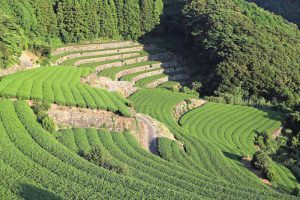
Tea fields in Higashisonogi Town (August 2018)
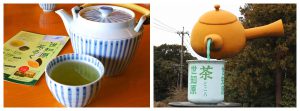
Sechibaru tea and an object of Sechibaru tea in Sechibaru Town (January 2019)
A Zen Buddhist monk Esai (Yosai) and Fushunen
Esai (1141-1215) travelled to Song (China) twice to learn about Zen Buddhism. When he returned to Japan the second time, he brought tea seeds back to Japan from Song in 1191. It is said that he propagated Zen Buddhism in Southern parts of Kyushu for 3 years after he returned Japan. Additionally, tradition says that Esai lived on Mt. Sefuri on the border between Saga and Fukuoka Prefectures and in Hirado, Nagasaki Prefecture in order to meditate, and planted the tea seeds there.
In Hirado, Esai built Fushunan for sitting in mediation and he planted tea seeds near the Fushunan. The tea garden is called Fushunen.
In 1211, he wrote a book about tea “Kissa Yojoki” (in English “Drinking Tea for Health”) which was the first tea book in Japan. The book mentions the benefits of tea, its cultivation and drinking methods of tea, etc.
Tea was already introduced to Japan in the 7th and 8th centuries, but tea had not yet spread throughout Japan at that time. Because of Esai, tea spread to a lot of places in Japan.
There is a stone where it is said that Esai sat in meditation at the ruins of Fushunan near Senkoji-temple in Hirado City.
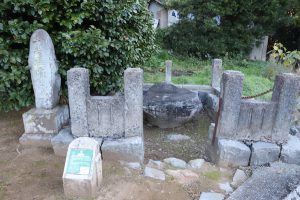
A stone where it is said that Esai sat in meditation (January 2019)
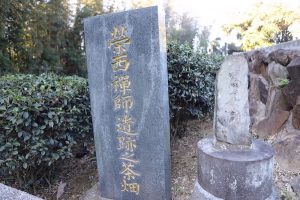
Tea garden of Fushunan (January 2019)
Oura Kei, a pioneer woman who exported Japanese tea to overseas
Oura Kei (1828-84) was a daughter of an oil merchant in Nagasaki City. She gave tea samples to a Dutch merchant to send it to Britain, America and Arabia in 1853. Kei exported a lot of tea produced in Kyushu from the end of the Edo Period until the beginning of the Meiji Period.
Nagasaki Ikedoki project
Tea tourism is promoted in English for foreign tourists in Higashisonogi Town by the Nagasaki Ikedoki project for introducing Japanese tea. A tea experience tour is conducted in which tourists can learn the history of Nagasaki and its tea, visit tea fields and a tea factory, and drink local tea. The project aims to spread the message of “Spread peaceful world with Japanese tea”.
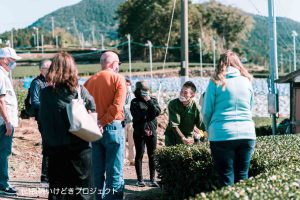
Tea tour for foreign visitors
Photo provided by Nagasaki Ikedoki project https://ikedokitea.com
Hasami ware
There are many colorful tea pots and teacups of Hasami ware. The prices are reasonable.
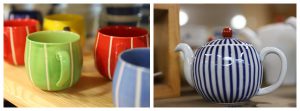
Tea cups and tea pot Hasami ware at Kuwarankan (January 2019)
サイト内関連記事「日本のお茶の生産状況」「お茶の種類 蒸し製玉緑茶」「旅 長崎いけどきプロジェクト」
Tea related facilities:
冨春園、冨春庵跡
くらわん館 http://kurawankashop.sakura.ne.jp¥
Tea mascot Yuru-Chara: Chako chan (Higashisonogi town)
Ceramic and pottery art: Hasami ware, Mikauchi ware
Reference:
松下智 (平成3年) 日本名茶紀行 (初版) 雄山閣出版
高野實・谷本陽蔵・富田勲・中川致之・岩浅潔・寺本益英・山田新市 (2005) 緑茶の事典 (改訂3版) 柴田書店
大森正司、阿南豊正、伊勢村護、加藤みゆき、滝口明子、中村羊一郎編(2017) 茶の事典 初版第一刷 朝倉書店
長崎県 https://www.pref.nagasaki.jp
ながさきの地産地消〜こだわりおかわり長崎産〜長崎県産茶の紹介
https://www.pref.nagasaki.jp/tisan/otya/
朝日まかて(2019) グッドバイ 第一刷 朝日出版社
長崎いけどきプロジェクト https://ikedokitea.com
*When visiting the shops and facilities introduced in this article, please check the business hours on their website, etc. before visiting.
*The information provided on this site may be updated. If you find any information in this article that is incorrect, new, or incomplete, please contact CHAMART.
*The site does not describe all “Teas of Japan” or all “Teas of the World”. Additionally, each article expresses the writer’s personal experience and feelings.
#higashisonogi #nagasaki